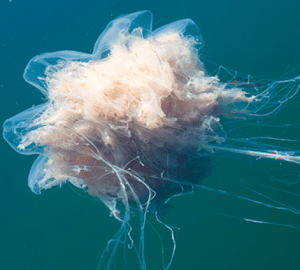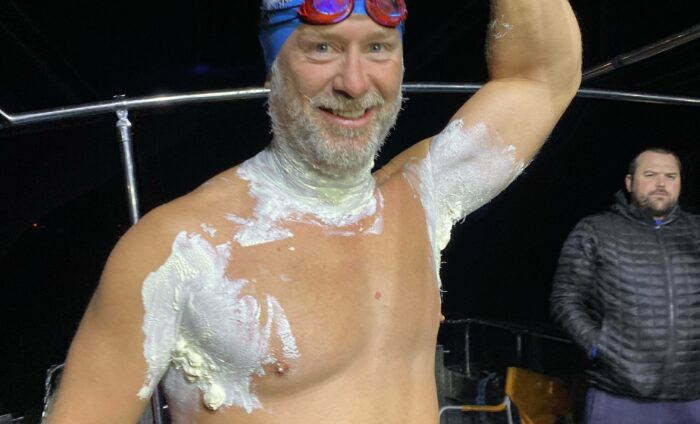
Making history in the English Channel
How Sam Penny, a 46-year-old Australian civil engineer turned cheesemaker, became the first person in history to attempt a winter crossing of the English Channel.
As he stood on Shakespeare beach at 4.30am on 4 December 2019, Sam Penny looked out into the darkness of the English Channel with the knowledge that no matter the outcome of the day, he was about to become the first person in history to attempt a Channel crossing in winter.
As the alarm on the support boat sounded and the cold December air swept around the body of a Channel swimmer for the very first time, Sam took to the water armed with no more than a pair of speedos, a swim hat, goggles and a healthy quantity of ocean-grease.
There were three things that had prepared Sam for this historic moment: physical fitness, acclimatisation to the environment and mental toughness.
He only had three months to prepare for this winter crossing – coincidentally the same amount of time he had to prepare for his first Channel swim. Swimmers usually need a year at least to train for a crossing in summer, let alone in winter. Yet Sam’s unique catalogue of open water swimming experience and methods of preparation meant that he was unlike other long-distance swimmers.
First Channel crossing
Growing up and swimming on the Sunshine Coast in Queensland, Australia, Sam always dreamt that he would one day swim the English Channel. “In the 70s and 80s, Channel swimmers were pretty much put up as gods,” says Sam. “Des Renford, Shelly Taylor-Smith, Susie Maroney – all legends of Australian sport. In the back of my mind they were always one of the motivators for me getting into open water swimming.”
Despite this childhood admiration for Channel swimming, Sam only properly took up open water swimming four years ago. He had always been a strong swimmer but had considered himself more of a sprinter than a long-distance swimmer. It wasn’t until open water racing really began to take off in Australia that he thought to give it a go.
“I started off with some 1km races. But they were 950m too far,” Sam laughs. “They felt so long, and at the end of them I just felt so spent. Even though my pool sessions were often 4km, 1km flat out in the ocean and I was done.”
But Sam stuck with it and he quickly grew a real love for open water swimming. “I don’t know why, but there’s something about being in the ocean that drew me more and more to it. Every time you’re in the ocean it’s different, a new adventure.”
Sam swimming with a wobbegong shark back home in Queensland, Australia
It was around this time (end of 2017) that Sam began to think again about the English Channel and what it would take to attempt it. He started watching YouTube clips of Channel swimmers, which ultimately gave him the motivation to finally commit to giving it a go.
“In the end, the biggest motivator for me to sign up was seeing a clip of David Walliams. I thought, the guy’s on Little Britain, he’s a comedian. If bloody David Walliams can do it, then so can I!” So, inspired by a British comedian, he signed up for a slot for the following year in August 2019, at which stage the longest swim Sam had done in open water was 1km.
During Christmas in 2017, he met with Tent Grimsey, a record-holding Channel swimmer, who now trains prospective Channel swimmers in Australia. Spurred on by his meeting with Trent, Sam swam 10km on the Sunshine Coast a week later on New Year’s Day. “Afterwards I just thought I was the biggest legend. I honestly felt as though I’d swam a double crossing. I was so wrecked, so buggered, and so proud of myself for getting out and just doing it.”
In April, Sam then attended a cold-water camp with Trent in Melbourne, during which time a slot for the Channel had become available for that August – a year before he was due to attempt his first crossing. “I’d already had half a bottle of wine when Trent basically said, ‘let’s bring it forward a year and let’s go for it’, and so we did.” One way or another, it was this decision – to some extent caused by the wine – that ultimately led to Sam’s record-breaking winter crossing a year later.
So, with nine months less than expected, Sam quickly began the first of his three-month Channel crossing preparations. His biggest week of swim training in those months only accumulated to 55km. But he was already very fit. He was having six pool sessions a week and completed six long ocean swims over the three months.
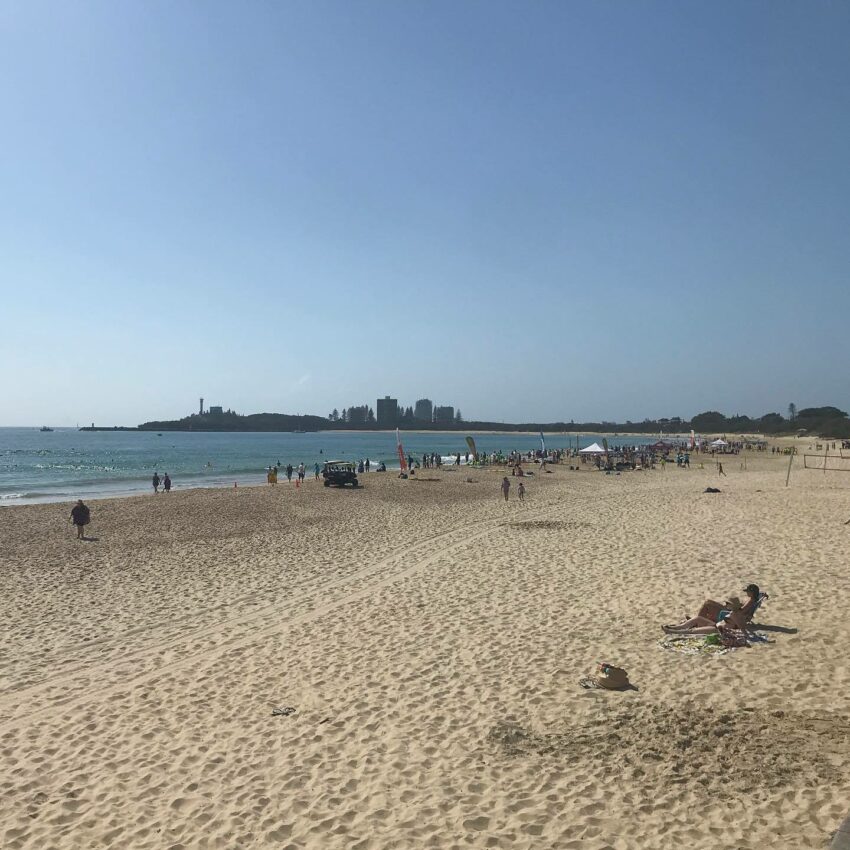
Sam prepared for his Channel crossings with long swims on Mooloolaba beach – Sunshine Coast, Australia
After a short three months’ preparation, in August 2018 Sam stood on the shores of Shakespeare beach, ready to take on the Channel for the first time.
“I thought it was so mad, so bizarre to be there after such a short time. In hindsight, I wouldn’t do it any other way. My track record shows that I have a three-month attention span.
“I’ve always had a philosophy where you’ve got to be ready for an opportunity when it presents itself. And that’s exactly what I had done. I’d been swimming six days a week for the previous three years.”
He was successful in his first Channel crossing, completing it in 11 hours and two minutes.
The double
So inspired by his achievement, Sam called up Michael Sage shortly after – Australia’s open water swimming coach – and signed up there and then for a double-crossing.
At the start of 2019 they teamed up to prepare for the double. “I was the old bloke at the end of the lane, but you really need to push yourself to achieve great things. I desperately wanted to do a double in 2020.”
Sam’s biggest fear for a double crossing was hypothermia. He realised that to swim for 20-22 hours, he needed to acclimatise to the temperature of the water in the Channel – which to do whilst living in the warmest state in Australia wasn’t easy. But Sam had an ingenious idea. “I got an old chest freezer and converted it into a plunge pool. I’d sit in it in the garage for half an hour a go at 2°C, which was great because it’s stinking hot here in Aus.”

The famous chest freezer
In July, Sam completed an Ice Mile in the Snowy mountains in Australia, where the water temperature was 3.9°C and the air temperature -2°C. A month later, Sam then did a Backyard Ultramarathon, which saw him run 6.7km every hour until one person was left standing. He beat half the ultramarathon runners who competed in the event, running a total distance of 87km.
He saw both of these challenges as vital to his preparation for a double crossing. “I knew I needed to acclimatise to the cold water and to be mentally tough, and to be able to push through as much pain as possible. My fitness and speed at this point were amazing, I just needed to be stronger mentally.”
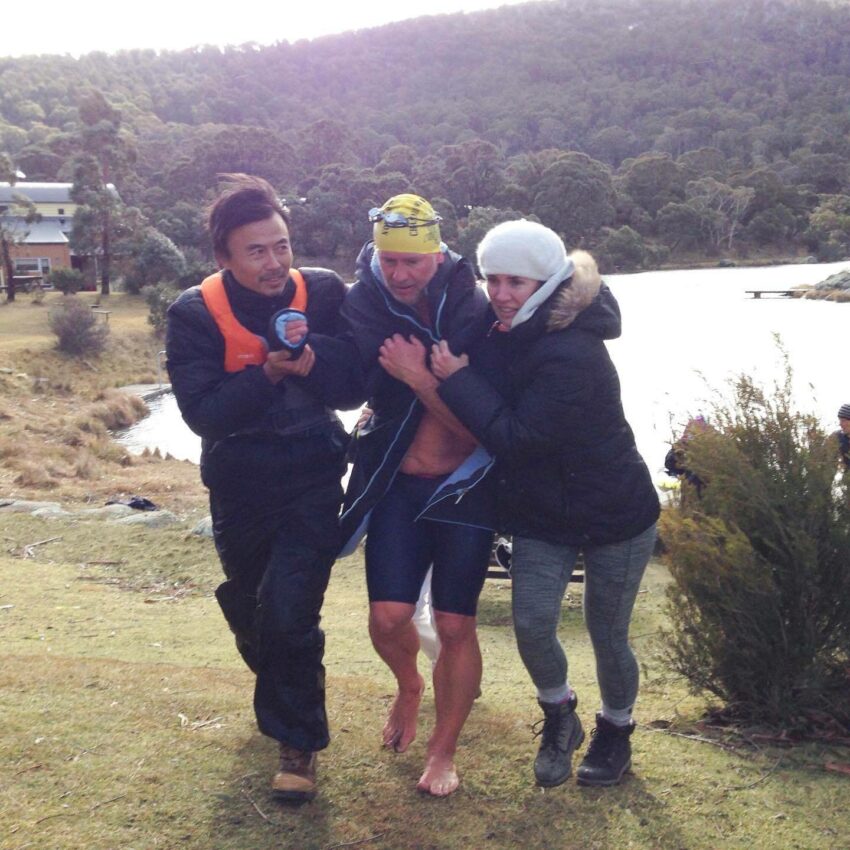
Sam after his Ice Mile swim at Lake Crackenback. He completed the mile in 25 minutes in 3.9-degree water.
It was in the middle of his preparations for a double-crossing, that Sam happened to stumble upon the records for the latest and earliest Channel crossings.
The historic winter crossing
“I was on the Channel swimming association website one day and I was looking at the records for the latest and earliest swims. Howard James, 3 November 2016. I remember thinking ‘that’s so mad, it’s so late in the season’. So I decided to find out more about it.”
As an ex-civil engineer, Sam loves data. And intrigued by what temperature the water was during Howard James’s latest Channel crossing record, he collated the daily December water temperatures for the English Channel for the past 11 years.
He found that when Howard crossed in November, the water was 14°C. “I thought, hang on a minute. I have friends who did the North Channel at the start of 2019 in 13°C. I’d done an ice mile and was so fit and fast at that moment. My cold-water acclimatisation was on point. I could beat Howard’s record.”
Using the data from previous years, Sam forecast that the water at the start of December was likely going to be around 12.5 degrees. “At 12.5, I thought I could definitely achieve it,” he thought. So with only three months to prepare, Sam changed his plans from a double crossing into a winter crossing attempt at the start of December 2019. “I saw this as a great opportunity to be the first in the world at attempting something and if I didn’t do it, then somebody else would. I wanted to be the first to try it.”
So three months later, on 1 December, Sam flew into London, at which point the UK was experiencing a cold period, with air temperatures hitting a maximum of 2°C. The Channel was holding at 12.5°C, but Sam and his team were concerned that the water temperature would drop further if they waited, and so they took the decision to head to Shakespeare beach for a crossing on 4 December.
“Looking out into the darkness on Shakespeare beach, it was just a perfect metaphor for me. Standing there, wet, cold, in speedos, knowing that not one person on the planet had stood there and done that thing. It was one of the most beautiful moments of my life.”
As the siren of the boat sounded, Sam let out a massive cheer and with a rush of adrenaline he dove straight into the 10°C waters of the Channel. “The water felt beautiful, not cold at all. And we started motoring.”
Despite an optimistic start, Sam and his crew knew from the beginning that the conditions were not ideal. “Mentally, the water wasn’t allowing me to get into a rhythm because it was so rough. But all the mental training that I had done allowed me to completely shut my mind off. My mind left my body and I went into the motion of what I had to do.”
After two and a half hours of swimming in the dark, the conditions were against Sam. The spotlight on the boat that had been shining onto him meant that he was struggling to see the waves. Rough conditions also meant that waves were coming at him from straight on and from the boat, and so he was starting to swallow water.
The waves from the boat
As the sun came up, Sam then experienced a second setback. “I saw this dark orange glow come up from the horizon and for the life of me I couldn’t work out what it was, it looked like a nuclear reaction had gone off. It really disorientated me because it was coming up in the north and I was expecting it in the south. For 20 minutes I couldn’t work out what was going on. I thought, ‘What’s going on?’ the boat’s going the wrong way. It was really throwing me off.” It was only when the sun then rose above the horizon that he realised what it was.
After three hours and 10 minutes, Sam then fell into a hole. He had maintained a strong pace for the first three hours with the boat staying in-gear, but all of a sudden he started to become disorientated. “I felt sick and my arms had seized up. My core felt warm, but I was starting to feel like I was going down, fast. I felt like I was starting to drown.” At that moment, he realised that he wasn’t going to make the next eight hours to France.
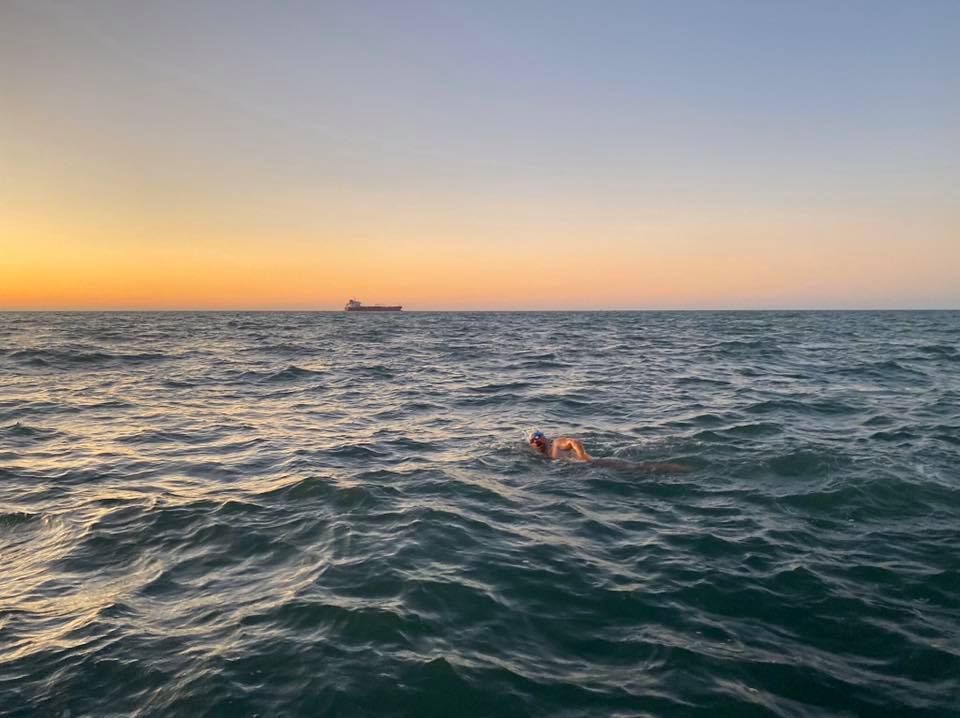
The sun rising (in the north!) as Sam heads towards France
His team on the boat could also see that Sam was struggling. So when Sam called up to Tim, “I feel shit, shall we cut it?”, they immediately stopped.
“I had four kids to consider. I wanted to make the decisions whilst I was still with it. The further I got into hypothermia, I knew that mentally I would struggle to make decisions and it would get dangerous,” he says.
At 07:57am Sam abandoned the crossing and made his way to the ladder at the back of the boat. His arms had seized up so badly because of the cold water, that as he climbed up the ladder, he lost his grip and fell backwards straight back into the water.
“The look on everyone’s face on the boat was one of pure horror. They didn’t want to hop in there after me. The air was 6°C and they were all in ski jackets, still cold. And there I was in the Channel for three hours in my speedos, so you can imagine what my body felt like.”
Sam swam back to the boat ladder and as he attempted to climb back onboard for the second time, Matt, one of his support crew, grabbed him by the back of his speedos and dragged him back into the boat. “It seriously gave me one of the biggest wedgies, which I couldn’t pick out for ages because my hands were like claws!”
It took Sam the rest of the day to recover from the swim. He felt sick most of the day, only feeling normal again around dinner time that evening. Though whilst he recovered and began to come to terms with failing to achieve what he had set out to do, support from around the world began flooding in.
“The amount of support and messages from around the world was phenomenal, it ignited the open water swimming community. The amount of people who have written to me and said what an inspiring thing that was. I didn’t make it to France, but everyone saw what it was – giving it a go. It was a beautiful experience.
“The outdoor swimming community has really backed this swim. I’m looking forward to seeing someone else crack it. The English Channel is the new frontier. We’ve seen Sarah Thomas’s four-way, which was such a mad feat. This is a doable swim and I would really like to see someone crack it, whether that’s me or someone else, who knows.”
Reflecting on the swim, Sam has said that he and his team have identified some areas that they would do differently if he were to give a winter crossing another go. And he remains undecided but albeit keen on giving it another shot.
Whether he has another attempt, or decides to take on a new challenge, on 4 December 2019 Sam entered the history books of English Channel swimming as the first person to ever attempt a crossing in winter – a remarkable and truly inspirational achievement.






